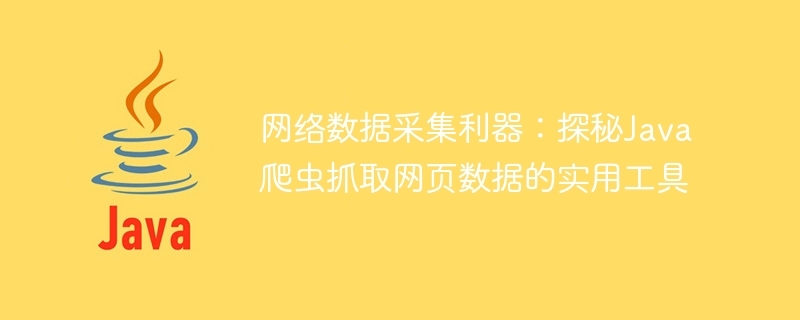Java爬蟲工具:揭秘網路資料擷取利器,抓取網頁資料的實用工具
- WBOYWBOYWBOYWBOYWBOYWBOYWBOYWBOYWBOYWBOYWBOYWBOYWB原創
- 2024-01-05 17:29:451254瀏覽

網路資料擷取利器:探針Java爬蟲抓取網頁資料的實用工具
導語:隨著網路的發展,大量的資料不斷產生和更新,對這些數據進行採集和處理,成為了許多企業和個人的需求。為了滿足這項需求,爬蟲技術應運而生。本文將探討Java語言下,用於抓取網頁資料的實用工具,並附帶具體程式碼範例。
爬蟲技術簡介
爬蟲技術是指利用程式自動化地存取並分析網路數據,從而獲取所需的資訊。在Java領域中,常用的爬蟲實作方式包括使用HttpURLConnection、Jsoup和HttpClient三個工具。以下分別介紹這三種工具的使用方法。
- HttpURLConnection
HttpURLConnection是Java自帶的一個包,用於發送HTTP請求和接收HTTP回應。透過HttpURLConnection讀取網頁的HTML程式碼,可以取得相關的資料。
以下是使用HttpURLConnection實作簡單爬蟲功能的範例程式碼:
import java.io.BufferedReader;
import java.io.IOException;
import java.io.InputStreamReader;
import java.net.HttpURLConnection;
import java.net.URL;
public class HttpURLConnectionExample {
public static void main(String[] args) throws IOException {
// 设置需要爬取的URL
String url = "http://example.com";
// 创建URL对象
URL obj = new URL(url);
// 打开连接
HttpURLConnection con = (HttpURLConnection) obj.openConnection();
// 获取响应码
int responseCode = con.getResponseCode();
System.out.println("Response Code: " + responseCode);
// 创建BufferedReader对象,读取网页内容
BufferedReader in = new BufferedReader(new InputStreamReader(con.getInputStream()));
String inputLine;
StringBuilder content = new StringBuilder();
while ((inputLine = in.readLine()) != null) {
content.append(inputLine);
}
in.close();
// 输出网页内容
System.out.println(content);
}
}- Jsoup
Jsoup是一款非常強大的Java HTML解析器,可用於解析、處理和操作HTML文件。使用Jsoup,我們可以輕鬆地取得網頁擷取所需的資料。
下面是使用Jsoup實作爬蟲功能的範例程式碼:
import org.jsoup.Jsoup;
import org.jsoup.nodes.Document;
import org.jsoup.nodes.Element;
import org.jsoup.select.Elements;
import java.io.IOException;
public class JsoupExample {
public static void main(String[] args) throws IOException {
// 设置需要爬取的URL
String url = "http://example.com";
// 使用Jsoup连接到网页
Document doc = Jsoup.connect(url).get();
// 获取所有的a标签
Elements links = doc.getElementsByTag("a");
for (Element link : links) {
// 输出a标签的href属性值和文本内容
System.out.println("Link: " + link.attr("href") + ", Text: " + link.text());
}
}
}- HttpClient
HttpClient是Apache開源組織提供的一個Java庫,用於傳送HTTP請求和處理HTTP回應。相較於HttpURLConnection,HttpClient具有更靈活和強大的功能。
以下是一個使用HttpClient實作爬蟲功能的範例程式碼:
import org.apache.http.HttpEntity;
import org.apache.http.HttpResponse;
import org.apache.http.client.HttpClient;
import org.apache.http.client.methods.HttpGet;
import org.apache.http.impl.client.DefaultHttpClient;
import org.apache.http.util.EntityUtils;
import java.io.IOException;
public class HttpClientExample {
public static void main(String[] args) throws IOException {
// 设置需要爬取的URL
String url = "http://example.com";
// 创建HttpClient对象
HttpClient client = new DefaultHttpClient();
// 创建HttpGet对象,设置URL
HttpGet request = new HttpGet(url);
// 发送HTTP请求
HttpResponse response = client.execute(request);
// 获取响应实体
HttpEntity entity = response.getEntity();
// 将实体转为字符串
String content = EntityUtils.toString(entity);
// 输出网页内容
System.out.println(content);
}
}總結
本文介紹了在Java語言下利用HttpURLConnection、Jsoup和HttpClient三個工具進行爬蟲的方法,並附帶相應的程式碼範例。這些工具具有各自的特性和優勢,在實際開發中根據需求選擇合適的工具非常重要。同時,我們也需要注意合法合規地使用爬蟲技術,遵守法律和道德規範,確保資料收集行為的合法性。
以上是Java爬蟲工具:揭秘網路資料擷取利器,抓取網頁資料的實用工具的詳細內容。更多資訊請關注PHP中文網其他相關文章!
陳述:
本文內容由網友自願投稿,版權歸原作者所有。本站不承擔相應的法律責任。如發現涉嫌抄襲或侵權的內容,請聯絡admin@php.cn

